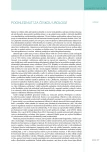EARLY SURGICAL MANAGEMENT OF URETERAL TRAUMA
Authors:
Jana Hlaváčová 1; Jan Jambura 1; Jiří Kouba 1; Jan Bulka 2; Viktor Eret 1; Milan Hora 1
Authors‘ workplace:
Urologická klinika LF UK a FN, Plzeň
1; Radiodiagnostické oddělení FN, Plzeň
2
Published in:
Ces Urol 2011; 15(3): 158-166
Category:
Original article
Overview
Aim:
We summarized our own experience and results of early surgical management of ureteral trauma (UT).
Methods:
In the period between January 1995 and January 2010 we treated 71 patients (15 men and 56 women) for UT. We evaluated our cohort in regard of advantage of indication of early surgical management. This is a retrospective study.
Results:
The mean age was 47 years (range 33–66). The most common cause of UT were gynaecological procedures (43%), less often endoscopical procedures (28%), colorectal operations (18%), ureter deliberations (5%), surgery of abdominal aortic aneurysm (3%), suprapubic prostatectomy (1.5%) and penetrating bullet trauma (1.5%). The UT was diagnosed by urine leakage into the operative wound in 18 cases, into the retroperitoneum in 16 cases, into the abdominal cavity 6 times and into the vagina 9 times. An obstruction causing the megaureter above was found in 19 cases, 2 times non-functioning kidney and once an anuria caused by bilateral ligature of ureters. As a surgical management of UT, there was indicated ureterocystostomy in 21 cases (15× early and 6× delayed), Boari bladder flap technique 6× (5× early and once delayed), 14× suture of the ureter (always peroperatively), 4× ureterorhaphy (3× early and once delayed), 1× substitution of ureter loop of small intestine(early) 2× nephrectomy (delayed), 10× nephrostomy (9× early and once delayed), 13× retrograde ureteral stent placement (11× early and 2× delayed).
Conclusion:
Regardless of the chosen method of treatment in our group it was possible to address the UT early (within one week after the correct diagnosis) in 58 patients (81.7%). This early access to definitive treatment of the UT we proved. The patient benefits in particular shortening of the treatment. The ultimate determination of advantage of early surgical treatment of UT, would have required a prospective randomized study.
Key words:
Boari bladder flap, intravenous pyelography, nephrectomy, ureteral trauma, retrograde ureteral stent placement, ureteroneocystostomy.
Sources
1. Hanuš T, Jarolím L, Petřík R, Matras B. Iatrogenní léze močovodu u žen. Rozh Chir 1997; 76(6): 302–305.
2. Schraml J, Knespl J. Laparoskopická poranění močovodu. Čes Urol 1998; 5: 33–35.
3. Pokuta P, Jarolím L, Dvořáček J, Hanuš T. Poranění močovodu ošetřená ve Všeobecné fakultní nemocnici v Praze za posledních 5 let. Urologická klinika 1. LF UK a VFN, Praha. Rozh Chir 1999; 78(12): 627–632.
4. Ghali AM, El Malik EM, Ibrahim AI, Ismail G, Rashid M. Ureteric injuries: diagnosis, management, and outcome. Asir Central Hospital, Abha, Saudi Arabia. J Trauma 1999; 46(1): 150–158.
5. Drake MJ, Noble JG. Ureteric trauma in gynecologic surgery. Int Urogynecol J Pelvic Floor Dysfunct 1998; 9(2): 108–117.
6. Schuster TG, Hollenbeck BK, Faerber GJ, et al. Complications of ureteroscopy: analysis of predictive factors. J Urol 2001; 166: 538.
7. Azimuddin K, Milanesa D, Ivatury R, et al. Penetrating ureteric injuries. Injury 1998; 29: 364.
8. Perez-Braytield MR, Keane TE, Krishnan A, et al. Gunshot wounds to the ureter: a 40-year experience at Grady Memorial Hospital. J Urol 2001; 166: 119.
9. Eikenberg H, Amin M. Gunshot wounds to the ureter. J Trauma 1976; 16: 562.
10. Palmer LS, Rosenbaum RR, Gershbaum MD, et al. Penetrating ureteral trauma at an urban trauma center: 10–year experience. Urology 1999; 54: 34.
11. Velmahos GC, Degiannis E, Wells M, et al. Penetrating ureteral injuries: the impact of associated injuries on management. Am Sung 1996; 62: 461
12. Bright T, Peters P. Ureteral injuries due to external violence: 10 years experience with 59 cases. J Trauma 1977; 17: 616.
13. Elliott SP, McAninch JW. Ureteral injuries from external violence: the 25-year experience at San Francisco General Hospital. J Urol 2003; 170: 1213.
14. Ghali AMA, El Malik EMA, Ibrahim AIA, et al. Ureteric injuries: diagnosis, management and outcome. J Trauma 1999; 46: 150.
15. McAninch JW. Present view of ureteral injuries. Urol List 2005; 3(1): 5–12.
16. McAninch JW. Renal and Ureteral injurie. In: Gillenwater JY, Grayhack JT, Howards SS. Adult and pediatric urology. 3 ed. Mosby 1996; 539–362.
17. DiGiacomo JC, Frankel H, Rotondo MF, et al. Preoperative radiographic staging is not warranted in patients undergoing celiotomy for trauma. Am Surg 2001; 67: 969.
18. Pešl M, Šafařík L, Pavlík I, et al. Kazuistika nemocné s oboustranným iatrogenním poraněním močovodů. Urologie pro praxi 2005; 3: 122–123.
19. Hanuš T, Novák K, et al. Nemoci močovodů. Praha: Galén 2008; 105–127.
20. Blandy JP, Badenoch DF, Fowler CG, et al. Early repair of iatrogenic injury to the ureter or bladder after gynecological surgery. J Urol 1991; 146: 761–765.
21. Tarkington MA, Dejter SWJr, Bresette JF. Early surgical management of extensive gynekologic ureteral injuries. Surg Gynecol Obstetr 1991; 173: 17–21.
22. Campbell EW, Filderman PS, Jacobs SC. Ureteral injury due to blunt and penetrating trauma. Urology 1992; 40: 216.
23. Medina D, Lavery R, Ross SE, et al. Ureteral trauma: Preoperative studies neither predict injury nor prevent missed injuries. J Am Coll Surg 1998; 186: 641.
Labels
Paediatric urologist Nephrology UrologyArticle was published in
Czech Urology

2011 Issue 3
Most read in this issue
- EARLY SURGICAL MANAGEMENT OF URETERAL TRAUMA
- Contribution of laparoscopy in diagnostics and treatment of non-palpable testes
- Late secondary bleeding after percutaneus nephrolithotomy
- Prevalence of the overactive bladder symptoms among patients of urological outpatient clinics
